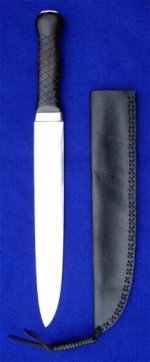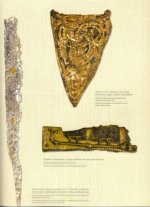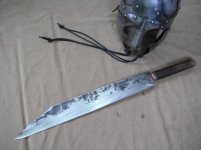While we are talking about the long knives, it is worth exploring the name of this weapon:
Old English seax,sax and Old Frisian sax are identical with Old Saxon and Old High German saks,all from a Common Germanic*sahsom froma root*sah,*sag-"tocut" (also insaw,from aPIE root*sek-).The term scramaseax,scramsaxlit."wounding-knife" is sometimes used for disambiguation, even though it is not attested in Old English, but taken from an occurrence of scramasax in Gregory of Tours'History of the Franks.[4]
http://en.wikipedia.org/wiki/Seax
So the wiki says it is an old German root *sah,*sag-"to cut and then quickly adds that it all comes from the PIE root sek.
http://en.wiktionary.org/wiki/Appendix:Proto-Indo-European/sek-
Interestingly enough wiki completely misses to mention Gaelic as a language that has anything to do with Seax or verb sek.
I will now try to fix this and try to expand this etymology with a very interesting word cluster which I found in south Slavic languages and in Irish.
I will start with this citation from a medieval French manuscript:
The Gaelic skills of hand-to-hand and their style of fighting was not lost, as a French observer Boullaye le Gouz comments in 1644: "The Irish carry a scquine (scian - knife) or Turkish dagger, which they dart (throw) very adroitly at 15 paces distance; and have this advantage, that if they remain masters of the field of battle there remains no enemy, and if they are routed, they fly in such a manner that it is impossible to catch them. [A common complaint by English Tudor soldiers] I have seen an Irishman with ease accomplish 25 miles a day. They march to battle with the bagpipes instead of fifes, butt hey have few drums and they use the musket and cannon as we do. They are better soldiers abroad than at home."
http://home.earthlink.net/~rggsibiba/html/galloglas/gallohist.html
The Irish long knife is called Scean or Scian. What is interesting about this word is that it is just one of a cluster of Irish words with the root sc which all somehow relate to blades, making blades, using blades and consequences of using blades. I will here just list few representative ones; you can consult the dictionary for more:
S(e)caineamh– shingly
S(e)clata– slate
S(e)caineadh-crack, split
S(e)ceallog– chip, thin slice
S(e)cealla– shale, flake
S(e)cablail– chisel work
S(e)caid– husks
S(e)caineach– thin, cracked
S(e)cean,s(e)cian (pronounced shkian) – knife
S(e)cean– crack, split, sever
Now these words, I believe, have potentially root in a stone age. When you look at them they basically describe making of a stone blade from a stone. You get a shingly stone, slate, you chip it, split it until you get a sharp blade. Husks and chips fall off in the process. Then you can use it to cut, split and sever…
From the analysis of the word development from Ogham Irish to modern Irish, we see that the language has lost a lot of vowels. To the above words could have had a vowel between Sc root and this is why I inserted the alternative “(e)” which doesn’t exist in modern Gaelic. We also see insertion of vowels in the south Slavic languages as the words traveled from the Baltic to the Balkans in the early medieval time. In some dialects of the south Slavic languages you can still find the original vowless versions of the words. So I am not sure about the above vowel insertion. Also you will see in related south Slavic words that we find both sk and sek roots.
Here is the corresponding south Slavic word cluster. You will notice that it is a lot bigger and wider than the Irish one, but it covers the same word range needed to describe making of a stone blade from as tone as well as all the metal blades and their usage. The fact that in the south Slavic languages we find all the words connected with the stone blades as well as the metal blades with the same root shouldn't surprise us. It was the Balkans, more precisely within the territory of today’s Serbia that metal blades were produced for the first time in copper, bronze and iron. It is fitting to presume that whoever made these metal blades used the same word s(e)k as the root word for both stone and metal blades. If this is so, what does this tell us about the age of these words?
Školjka– shell. Shells are sharp and could have been what gave people idea to create first blades
Skriljac– slate. This stone can be easily chipped and was used for weapon blades.
Skresati– from kresati. Kresati means to hit one thing with another, so that the hitting thing slides of the side of the thing being hit. The word is used to describe hitting a stone with a stone to chip them or to make fire and for cutting branches of a log, basically to chip or to trim. Skresati means to actually chip a bit of or to cut a brunch off, to separate bits.
Skalja– small thin chips of stone or wood
Sek(sometimes pronounced as sik or sk)– root word meaning to cut but also a blade. Word seći(to cut) comes from sekti.
Sečivo(pronounced sechivo) – blade
Sekira(sikira, skira) – axe
Sekare(škare pronounces shkare) – scissors
Sekia(sekian) – knife. This word is now preserved in Bosnian slang word for knife “ćakija” (sekia). This word can also be deduced from a word škia (pronounced shkia) which is a dinaric dialect word which means a thin hand sliced tobacco.
Sekač.– a one sided blade
Skiljiti– to squint, to make your eyes look like as if they were two cuts.
Skija– a blade on a sled, and later a ski.
Sekutić – front tooth
Usek,zasek – a cut
Sek– a log house where logs, which are also called sek, are connected by interlocking cuts made at their ends.
Seknuti– to strike or hit suddenly
Skratiti– to cut down to cut short
Skrvaviti– to make bloody
Skloca– foldup knife
Škljocati- to make a noise by closing something sharp like teeth or scissors.
Škrgutati– to grind teeth
Škopiti– to castrate, to cut balls off.
Skulj– a castrated ram
Škrip– a cut, a narrow space
This word cluster is possibly based on an onomatopoeic root “sk” which potentially makes it very old. The sound which a blade makes when pulled across something in order to cut it is “sssssssk”. When you cut something off with a sudden hit of blade sound shortens to tsk or tsak. I will leave this here and hopefully someone else will pick it up and cover it in more detail.
What I find is very very interesting is word for scissors. Scissors are a complicated implement and who ever made them first gave them the name that stuck among the people who used them first, which probably related people who were living close together.
In Russian and all central and east Slavic languages (including Bulgarian and Macedonian) it is a form of word nožnice.
In Scandinavian languages it is some form of saks.
In French English and Irish it is ciseaux, scissors, siosúr.
In Greek and Latin it is ψαλίδιand axicia
In Italian it is forbici.
But in Serbian, Croatian, Bosnian, Slovenian, Dutch, German and Latvian it is škare,schaar, schere, š??res…So what is the connection between these people? Is south Baltic the link again, more precisely Elbe valley?
We know that the root word is sekare which comes from south Slavic sek root. Because when we have a look at the word for cut and blade in all these languages we get this:
To cut
German - geschnitten (is this actually sekniten)
Dutch– snijden (this is probably from the above root sekniten)
Latvian– samazin?t
Serbian,Croatian, Bosnian, Slovenian – Seći(Sekti)
Blade
German– Schneide (Sekniede?), Klinge
Dutch– mes
Latvian– asmens
As part of this analysis I have to mention one more word: to slaughter,to kill a living thing using a sharp blade. We need to investigate this word because after all, blades are made for slaughter more than anything else.
In south Slavic languages a word for to slaughter or related to slaughter are:
Klati– to slaughter
Klanje– slaughter
Klan– being slaughtered
Koljač– the one that slaughters
Saklan(zaklan) – slaughtered
Kljakav– someone who is missing a limb due to its being cut off.
Kljuse– a horse which is too old to be useful and which needs to be slaughtered, killed (kolje se)
Kljusav– ready to be slaughtered, killed
Koljivo– a ceremonial meal made from cooked wheat eaten at Serbian “Slava”celebration. Slava is today a family patron saint day celebration,but originally it was a clan ancestral cult celebration. Each family had its own deity as a clan progenitor, and that deity was celebrated as the father of the clan. Originally human sacrifices were made even down to medieval times and maybe even later. In case of Dabog or Hromi Daba, the main deity of all Serbian clans, even first born children were sacrificed. Animals such as lambs, goats and bulls were also sacrificed and are still to this day. Animal sacrifices and particularly human sacrifices sharply distinguished Serbs and other western Slavs from eastern Slavs. During slavisation of the Serbs,blood sacrifices were replaced with cooked wheat but the name remained: koljivo (what was slaughtered as a sacrifice).
Word klati is an onomatopoeic word based on the root “kl” which potentially makes it very old as well.
“kl”or “gl” is, I believe, one of the oldest word roots which is related to things coming out of a throat. It is particularly a sound of choking of gasping for air while something liquid is filling your throat and lungs, like blood when an animal or a person is being slaughtered. If you have ever slaughtered anything you will not easily forget that sound. The sound is kljkljklj….
In south Slavic languages we have this word
Krkljati– gargle
Kuljati– to gush, as in puking or bleeding when a throat is slit, or bleeding when a body is sliced open with a blade, or a head crushed with an axe blow.
kljukati - continuously stuff something down someones throat.
It is interesting how much this klati sound like kill. In wiktionary we find this as etymology of kill:
From Middle English killen,kyllen,cüllen(“to strike, beat, cut”),possibly a variant of Old English cwellan(“tokill, murder, execute”)(seequell),or from Old Norse kolla(“tohit on the head, harm”)(compare Norwegian kylla(“topoll”),Middle Dutch kollen(“toknock down”),Icelandic kollur(“top,head”),see coll,cole).Compare also Middle Dutch killen,kellen(“tokill”),Middle Low German killen(“toache strongly, to cause one great pain”),Middle High German kellen. Cognate with Albanian qëlloj(“tohit, strike”).
http://en.wiktionary.org/wiki/kill
I think these words are related, but I will leave this to others to investigate further.
Now we also have word klanac which means a gorge, a deep narrow valley out of which a river flows. These valleys are deep cuts in hills and mountains which look as if they were made by a gods using giant blade. Out of these earth wounds, water, the blood of the earth gushes out.
This is incredible descriptive naming of geological formations, as klanac does also resemble a deep cut made by a blade in a flesh, especially in a neck while slaughtering out of which blood starts gushing out.If you have ever slaughtered anything or anyone you will know what I am talking about.
So klanac is a place where mother earth has been slaughtered. How old could this word possible be?
Now in Gaelic we have this word: Glen. The word is Goidelic : gleann in Scottish and Irish Gaelic, glion in Manx.In Manx,glan is also to be found meaning glen. It is cognate with Welsh glynl.
Wiktionary says that it means: A secluded and narrow valley;a dale;a depression between hills.
http://en.wikipedia.org/wiki/Glen
http://en.wiktionary.org/wiki/glen
we also have word claon: inclining, squint, oblique, Irish claon,Old Irish clóin:*kloino-;Latincli@-no,accli@-nis,leaning, English incline;Greek@Gklínw(@Gilong),incline; English lean;Lithuanian szlë/ti,incline; Sanskrit çrayati(do.).
So here we have a link between to slaughter, to cut a slit, to squint,klanac (glen, gorge)…
Also it is interesting that in Germanic languages the word for slaughter has the same root (s-kl) as in south Slavic languages (Schlachten,s(e)klahten), but in east Slavic and central Slavic languages it is based on the root “rez” which also means to cut in Slavic languages. This again shows the affinity of south Slavic languages with Germanic languages. This also shows that south Slavic languages kept their old word for cut (sek) and also absorbed the new Slavic word (rez).






